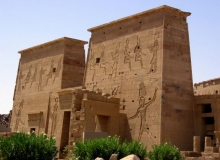
Speak to a specialist
0208 777 4873
0208 777 4873
Temple of Philae

Philae is mentioned by numerous ancient writers, including Strabo, Diodorus, Ptolemy, Seneca, Pliny the Elder. It was, as the plural name indicates, the appellation of two small islands situated in latitude 24° north, just above the First Cataract near Aswan (Ancient Egyptian: Swenet, "Trade;" Ancient Greek: Syene). Groskurd computes the distance between these islands and Aswan at about 61.5 miles (99 km).
Philae proper, although the smaller island, is, from the numerous and picturesque ruins formerly there, the more interesting of the two. Prior to the inundation, it was not more than 1,250 feet (380 m) long and about 400 feet (120 m) broad. It is composed of Syenite stone: its sides are steep and on their summits a lofty wall was built encompassing the island.
Philae, being accounted one of the burying-places of Osiris, was held in high reverence both by the Egyptians to the north and the Nubians (often referred to as Ethiopians in Greek) to the south. It was deemed profane for any but priests to dwell there and was accordingly sequestered and denominated "the Unapproachable". It was reported too that neither birds flew over it nor fish approached its shores. These indeed were the traditions of a remote period; since in the time of the Ptolemies of Egypt, Philae was so much resorted to, partly by pilgrims to the tomb of Osiris, partly by persons on secular errands, that the priests petitioned Ptolemy Physcon (170-117 BC) to prohibit public functionaries at least from coming thither and living at their expense. In the 19th century AD, William John Bankes brought the Philae obelisk on which this petition was engraved to England. When its Egyptian hieroglyphs were compared with those of the Rosetta stone, it threw great light upon the Egyptian consonantal alphabet.
The islands of Philae were not, however, merely sacerdotal abodes; they were the centres of commerce also between Meroë and Memphis. For the rapids of the cataracts were at most seasons impracticable, and the commodities exchanged between Egypt and Nubia were reciprocally landed and re-embarked at Syene and Philae.
The neighbouring granite quarries also attracted a numerous population of miners and stonemasons; and, for the convenience of this traffic, a gallery or road was formed in the rocks along the east bank of the Nile, portions of which are still extant.
Philae also was remarkable for the singular effects of light and shade resulting from its position near the Tropic of Cancer. As the sun approached its northern limit the shadows from the projecting cornices and moldings of the temples sink lower and lower down the plain surfaces of the walls, until, the sun having reached its highest altitude, the vertical walls are overspread with dark shadows, forming a striking contrast with the fierce light which illuminates all surrounding objects.
Subscribe here to our monthly newsletters


